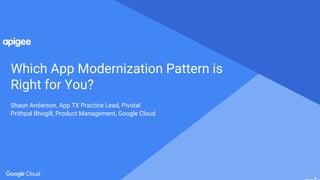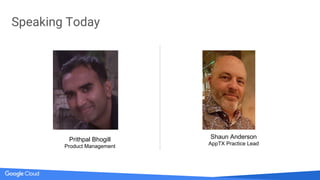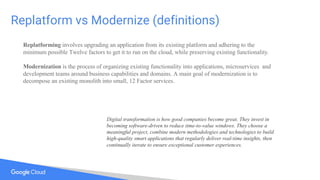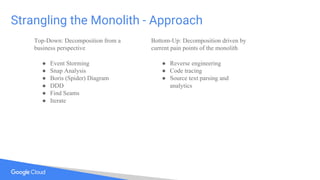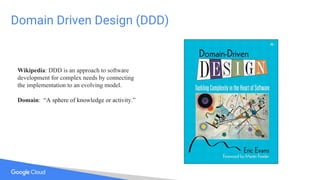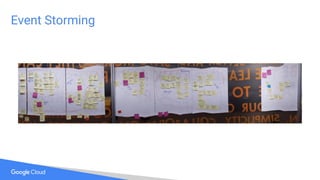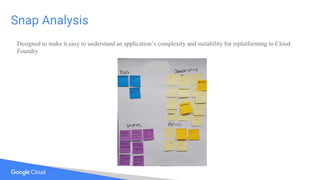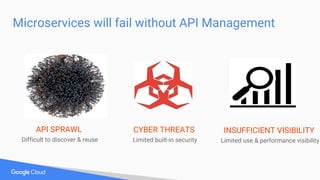Which Application Modernization Pattern Is Right For You?
- 1. Proprietary and confidential Which App Modernization Pattern is Right for You? Shaun Anderson, App TX Practice Lead, Pivotal Prithpal Bhogill, Product Management, Google Cloud
- 2. Reminder: “This webinar may include mention of some future features. Please make any purchasing decisions based on currently GA features. This information is Google confidential information, covered by the terms of Apigee and Google Cloud Platform License Agreement.”
- 3. Speaking Today Prithpal Bhogill Product Management Shaun Anderson AppTX Practice Lead
- 4. Agenda Why modernize? Strangling the Monolith Why API Management? Apigee and Pivotal Cloud Foundry Customer Benefits Call to Action
- 5. What is Pivotal Cloud Foundry?
- 6. Overview of Cloud Foundry Pivotal Cloud Foundry is a platform for developing and running cloud applications
- 8. Traditional App Lifecycle: Lengthy & Complex Traditional Deployment: 8+ manual steps, developers out of the workflow Traditional App Lifecycle: Each phase compounds time and complexity, sacrificing agility
- 9. The Power of Cloud Native Platform
- 10. Why Modernize?
- 11. Why Monoliths Can Be Bad - Slow velocity and release cycle - Knowledge is compartmentalized - The code base is just too large for any one person to fully comprehend - Centralized authority and change management slows progress (DBA, Ops) - Inefficient infrastructure utilization - Reliance on expensive software - Non-standard toolsets
- 12. Why Replatform / Modernize ● Lower CapEx and OpEx ○ Moving away from full-blown application servers that are expensive to license, operate, and administrate has been a consistent market trend since 2004 ● Increased scalability, provider portability ○ Vertical scalability is inherently limited. Cloud platforms can horizontally scale up or down in seconds, dynamically—even auto scale ● Optimize hardware resource usage, cost ○ Containerizing and virtualizing applications increases deployment density on the hardware or IaaS, ensuring maximum utilization of system resources, and deallocation or reallocation when idle ● Increased developer productivity without losing operations controls ○ When developers can self service, instantly provisioning an environment that uses platform-wide access controls and audit trails, it’s a win for operations teams that can set consumption parameters ● Enabling DevOps with common management and monitoring tools ○ Modern clouds provide agentless health management that streams an integrated, near real-time view of key application, services, and platform metrics. Developers and operators gain a shared understanding of the same system health and availability data in cloud environments.
- 13. Replatform vs Modernize (definitions) Replatforming involves upgrading an application from its existing platform and adhering to the minimum possible Twelve factors to get it to run on the cloud, while preserving existing functionality. Modernization is the process of organizing existing functionality into applications, microservices and development teams around business capabilities and domains. A main goal of modernization is to decompose an existing monolith into small, 12 Factor services. Digital transformation is how good companies become great. They invest in becoming software-driven to reduce time-to-value windows. They choose a meaningful project, combine modern methodologies and technologies to build high-quality smart applications that regularly deliver real-time insights, then continually iterate to ensure exceptional customer experiences.
- 14. The Cloud Native Application Journey
- 15. Strangling the Monolith - Approach ● Event Storming ● Snap Analysis ● Boris (Spider) Diagram ● DDD ● Find Seams ● Iterate Top-Down: Decomposition from a business perspective Bottom-Up: Decomposition driven by current pain points of the monolith ● Reverse engineering ● Code tracing ● Source text parsing and analytics
- 16. Domain Driven Design (DDD) Wikipedia: DDD is an approach to software development for complex needs by connecting the implementation to an evolving model. Domain: “A sphere of knowledge or activity.”
- 17. Event Storming
- 18. Event Storming
- 19. Event Storming
- 20. Snap Analysis Designed to make it easy to understand an application’s complexity and suitability for replatforming to Cloud Foundry
- 21. Enhanced Snap Analysis Used to describe a modernized service -- usually this service consists of functionality from one or more monoliths.
- 22. Spider Diagrams
- 23. Test Driven Development (TDD) Test-Driven Development (TDD) is a technique for building software that guides software development by writing tests. It was developed by Kent Beck in the late 1990's as part of Extreme Programming. In essence you follow three simple steps repeatedly: Write a test for the next bit of functionality you want to add. Write the functional code until the test passes. Refactor both new and old code to make it well structured.
- 24. Finding Seams The Goal: Find areas of an existing monolith that can be pulled apart and reorganized without impacting the functionality of the existing system. Control Patterns ● Event shunting / starving ● Decorator ● Bridge ● Router ● Proxy ● Facade ● Edge Gateway - Apigee
- 25. Iterate vs Big Bang rewrite Iterate ● Succeed Fast / Fail Fast ● Allows for innovation ● Conforms to changing requirements ● Allows for dynamic and balanced teams ● Pairing enables Dev Team Mitosis
- 27. APIs and Microservices are complementary CATALOG CUSTOMER REVIEWS FAVORITES RECOMMEND ORDERS SHOPPING CART Microservices eCommerce System Monolithic eCommerce System APIAPI
- 28. APIs shield consumers from Microservices Complexity Ordering API Customer APIBilling API Consumers Shouldn’t Care About What’s Behind the API
- 29. Microservices will fail without API Management API SPRAWL Difficult to discover & reuse CYBER THREATS Limited built-in security INSUFFICIENT VISIBILITY Limited use & performance visibility
- 30. API Gateway Developers Developer Portal Apigee API Platform Analytics Management Management Runtime Services App API Team Scalable Services Microgateway Technology powering the Apigee API Platform Available as Apigee managed + Customer managed A family of federated gateways Available native integration capability with respective cloud
- 31. Comprehensive API Management OAuth2, OpenID, SAML, TLS OWASP Threat Protection RBAC, 3rd party IDM Support Bot Detection Mediation, Caching & Traffic Management node.js run-time Engine Data Persistence / BaaS Hybrid Deployment / Microgateway Secure API RuntimeApps Services Business & Developer Metrics Fine-grained Performance Analytics End User Analytics Custom Data Capture & Reports Trace & Diagnostics Analytics Customizable Developer Portal SmartDocs Self-service Developer On-boarding API Products API Monetization Developer Management Partners / Developers API-driven Platform Automation Multi-tenancy & Scaling with Traffic Isolation Zero Downtime Upgrades Cross-region Automated Routing & Failover Global Policy Enforcement Operations Automation Flow-based Proxy Editor & Pre-built Policies API Studio with Open API / Swagger Test & Monitoring Extensibility with node.js / Java Version Management API Development API Team
- 32. Apigee provides the API layer for Microservices CATALOG CUSTOMER REVIEWS FAVORITES RECOMMEND ORDERS SHOPPING CART Microservices eCommerce System Apigee’s centralized gateway provides comprehensive API management and an API layer for your microservices CATALOG Apigee’s microgateway provides security, throttling and analytics for individual microservices as well.
- 34. What we are doing together? added support for Edge Microgateway... We’ve integrated our products… released BOSH Installers for Apigee Edge
- 35. Integration Options - Flexibility & Choice Route Services CF Meta Buildpack* * Edge Microgateway Buildpack available today as OSS on https://github.com/swilliams11/edgemicro-decorator. Apigee Edge MicrogatewayApigee Edge Enterprise App App App Apigee Edge Microgateway
- 36. Application Modernization CATALO G CUSTO MER REVIEW S SHOPP PING CART RECOM MEND Mobile & Web apps Virtualized Apps and Microservices On-Premises, Legacy Apps Monitor performance & usage of both legacy and modern services Mitigate migration risk with automated routing of API requests Routing Security Analytics Secure your services from cyber threats and traffic spikes
- 37. Benefits for Developers & Operators Developers • Apply pre-built traffic management and security features to their app • Apply pre-built pricing models to monetize their app • Automatically expose their app (as services) to other developers • Discover, test, and obtain access to other services (as APIs) Accelerate Application Modernization Operators • Apply a set of security and traffic management features across projects • Scale these features through PCF • Obtain visibility into the usage and performance of APIs • Install and manage Apigee Edge through BOSH Ease Operational Concerns
- 38. Powering the “Digital Value Chain” Consuming digital products and digital experiences “Outside-in” – digital consumer view User App Developer API API team Services Reduce time to develop connected experiences Enable consumption of APIs Reduce time to build better software Reduce operational complexity
- 39. Key Takeaways Modernizing applications can have a huge ROI It doesn’t have to be hard - start small APIs and Microservices are complementary Use API Management as you transition into Microservices Enterprise customers are using this approach successfully
- 40. Appendix
- 41. Call to Action Visit www.apigee.com and sign up for a trial account Learn about Apigee’s integrations with Pivotal here If you are new to Apigee Learn more about Apigee’s Service Broker with Edge Microgateway here Ask your PCF rep about Apigee’s free Microservices Starter Kit offer Ask you PCF rep for an introduction to Apigee Sales If you are PCF Developer or Operator Visit www.pivotal.io to learn how to develop and deploy software with cloud native techniques Ask your Apigee rep for an introduction to Pivotal Sales. If you are new to Pivotal
- 42. REST APIs - Enable easy consumption REST APIs enable easy consumption CONTAINERS enable independent deployment CLOUD enable independent scaling
- 43. For the Full API Lifecycle Design Develop Secure PublishMonitor Analyze Monetize Scale
- 44. CommonSecurityModel-OAuth ThreatProtection Caching Monetiza tion/Rate Plans External API Façade & Proxy Mediation/Aggregation Developer Portal Use API management as you transition to microservices CATALO G CUSTOM ER REVIEW S SHOPPPI NG CART RECOM MEND Mobile & Web apps Microservices Apigee authenticates, applies security policies and routes request to microservices. Also orchestrates to your legacy services/monolith apps On-Premises or Private Cloud Monolith Apps

